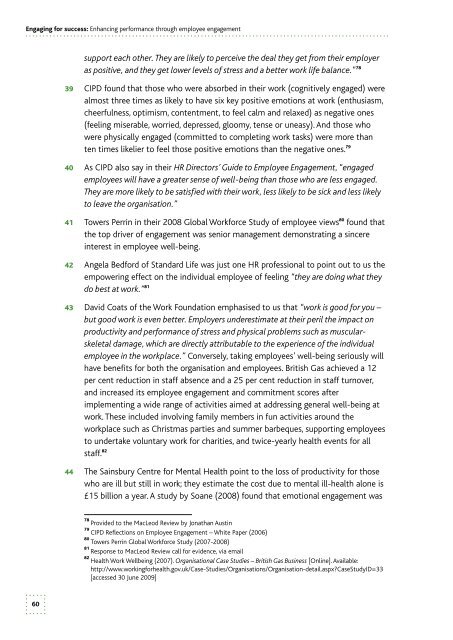3ytgeaf
3ytgeaf
3ytgeaf
Create successful ePaper yourself
Turn your PDF publications into a flip-book with our unique Google optimized e-Paper software.
Engaging for success: Enhancing performance through employee engagement<br />
support each other. They are likely to perceive the deal they get from their employer<br />
as positive, and they get lower levels of stress and a better work life balance.” 78<br />
39 CIPD found that those who were absorbed in their work (cognitively engaged) were<br />
almost three times as likely to have six key positive emotions at work (enthusiasm,<br />
cheerfulness, optimism, contentment, to feel calm and relaxed) as negative ones<br />
(feeling miserable, worried, depressed, gloomy, tense or uneasy). And those who<br />
were physically engaged (committed to completing work tasks) were more than<br />
ten times likelier to feel those positive emotions than the negative ones. 79<br />
40 As CIPD also say in their HR Directors’ Guide to Employee Engagement, “engaged<br />
employees will have a greater sense of well-being than those who are less engaged.<br />
They are more likely to be satisfied with their work, less likely to be sick and less likely<br />
to leave the organisation.”<br />
41 Towers Perrin in their 2008 Global Workforce Study of employee views 80 found that<br />
the top driver of engagement was senior management demonstrating a sincere<br />
interest in employee well-being.<br />
42 Angela Bedford of Standard Life was just one HR professional to point out to us the<br />
empowering effect on the individual employee of feeling “they are doing what they<br />
do best at work.” 81<br />
43 David Coats of the Work Foundation emphasised to us that “work is good for you –<br />
but good work is even better. Employers underestimate at their peril the impact on<br />
productivity and performance of stress and physical problems such as muscularskeletal<br />
damage, which are directly attributable to the experience of the individual<br />
employee in the workplace.” Conversely, taking employees’ well-being seriously will<br />
have benefits for both the organisation and employees. British Gas achieved a 12<br />
per cent reduction in staff absence and a 25 per cent reduction in staff turnover,<br />
and increased its employee engagement and commitment scores after<br />
implementing a wide range of activities aimed at addressing general well-being at<br />
work. These included involving family members in fun activities around the<br />
workplace such as Christmas parties and summer barbeques, supporting employees<br />
to undertake voluntary work for charities, and twice-yearly health events for all<br />
staff. 82<br />
44 The Sainsbury Centre for Mental Health point to the loss of productivity for those<br />
who are ill but still in work; they estimate the cost due to mental ill-health alone is<br />
£15 billion a year. A study by Soane (2008) found that emotional engagement was<br />
78<br />
Provided to the MacLeod Review by Jonathan Austin<br />
79<br />
CIPD Reflections on Employee Engagement – White Paper (2006)<br />
80<br />
Towers Perrin Global Workforce Study (2007-2008)<br />
81<br />
Response to MacLeod Review call for evidence, via email<br />
82<br />
Health Work Wellbeing (2007). Organisational Case Studies – British Gas Business [Online]. Available:<br />
http://www.workingforhealth.gov.uk/Case-Studies/Organisations/Organisation-detail.aspxCaseStudyID=33<br />
[accessed 30 June 2009]<br />
60


